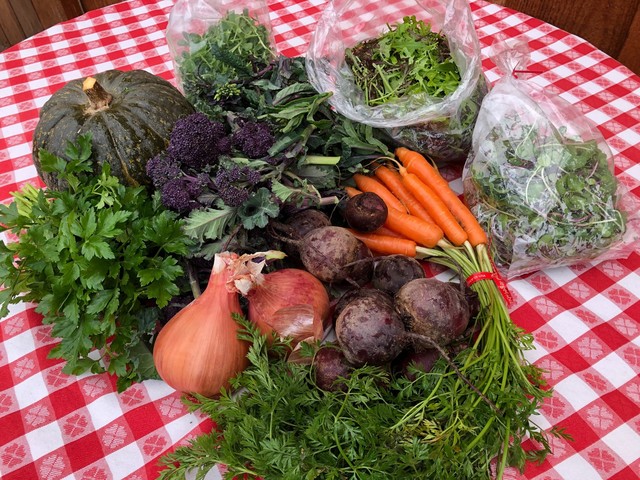What's in your Share this Week:
- Baby Bunch Carrots - hurrah! Our first harvest from our overwintered greenhouse plantings. Seeded last September, this is our winter "candy carrot" variety that performs well in cold weather. It's a 6 month waiting game for these babies and always a full-blown celebration when we finally get to dig our first sweet, crunchy harvest.
- Winter Baby Greens - a mix of mustards, mizuna, tatsoi and other Asian greens
- Shallots - our longest-storing allium. This variety is supposed to produce single shallots, but very often it throws doubles. I wish it wouldn't do that because the outer skin is thick and tight, which in our damp climate can trap humidity between the two shallot bulbs (even in our climate-controlled, insulated storage room). It means that you might see a faint trace of grey mold between the two bulbs when you start peeling back the outer skin. It's minor and only affects the skin, so not to worry. Just peel away and you'll have a beautiful lavender shallot waiting for you just beneath the surface.
- Red Beets
- Purple Sprouting Broccoli
- Spring Raab
- Italian Parsley
- Tetsukabuto Winter Squash - our longest-keeping winter squash, built for the apocalypse (the Japanese name translates to "steel helmet," a nod to it's super-hard skin). If you don't feel like eating this squash right away, that's fine; it'll still be good in June. It's a yummy kabocha type with sweet dry flesh that shines in Thai curry, tempura, or hacked into wedges and roasted with olive oil and sea salt. Take care with this one when you're cutting into it!
- Radish Micro Mix - a new mix we're growing this winter, as colorful as confetti. It's got a spicy kick - goes great on tacos!
- Pea Shoots - Bonus! We hadn't planned on doling out more pea shoots to you this week, but we had a bumper harvest this week and decided to share! If you didn't try that pistachio pea shoot pesto recipe I suggested last time, do it! Soooooooo good!
All in all this week, a nasty couple days to be farming outside. This kind of weather is what we've always referred to as "lamb-killing rain:" temps in the low 40's/high 30's, steady rain, a cold wind. That combo is colder than 30 degrees and snowing, owing to the damp chill that penetrates bone-deep. It can suck the life right out of the wet, newborn lambs that get born in the middle of the night in some far corner of the pasture. We raised sheep when I was a kid and I was my mom's right-hand helper during lambing season. I remember the heartbreak of finding a dead or torpid lamb out in the pasture on morning patrol before school. (Most of the time the ewes that were showing imminent signs of labor would be penned in the barn ahead of time so they could birth indoors, but sometimes a ewe would birth without showing pre-labor signs. And always it was in the middle of the night.)
We'd bring the half-dead lambs in by the woodstove, wrap them in old sweaters, tube some warm milk into them, and cross our fingers. Sometimes an hour later they'd be up and bouncing, a complete resurrection. But not always. With lambing season in full swing all around us right now, I can't help but hope that the lambs are weathering the weather all right, ideally under the roof of a barn.
For us, thank goodness for wool long underwear (gratitude to the sheep), our layers of down (gratitude to the geese), and our final wrap of Grunden's raingear (gratitude to the petroleum industry and the fishermen). It's just the hands that stop working after awhile. A lot of the crops we harvest are not glove-compatible. Gloves - particularly insulated ones - rob us of our dexterity and make knifework clumsy and slow, so inevitably we end up with ten naked, achey, and numb digits. Good luck working your zipper at a certain point in the day...
But then there's the hot shower, the woodstove, and a heaping plate of fresh-cut salad waiting for you at the end of the day, which usually evens the score.
Have a great week!


